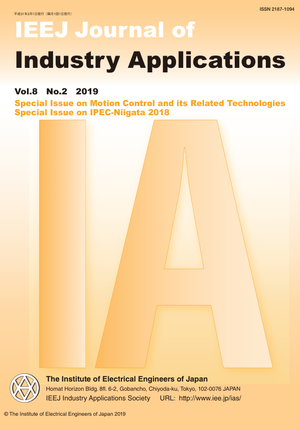Backlash-based Shock Isolation Control for Jerk Reduction in Clutch Engagement
Backlash-based Shock Isolation Control for Jerk Reduction in Clutch Engagement
カテゴリ: 論文誌(論文単位)
グループ名: 【D】産業応用部門(英文)
発行日: 2019/03/01
タイトル(英語): Backlash-based Shock Isolation Control for Jerk Reduction in Clutch Engagement
著者名: Akira Yamaguchi (Motion Control Labs., Nagaoka University of Technology), Kiyoshi Ohishi (Motion Control Labs., Nagaoka University of Technology), Yuki Yokokura (Motion Control Labs., Nagaoka University of Technology), Toshimasa Miyazaki (Motion Control L
著者名(英語): Akira Yamaguchi (Motion Control Labs., Nagaoka University of Technology), Kiyoshi Ohishi (Motion Control Labs., Nagaoka University of Technology), Yuki Yokokura (Motion Control Labs., Nagaoka University of Technology), Toshimasa Miyazaki (Motion Control Labs., Nagaoka University of Technology), Kotaro Sasazaki (Motion Control Labs., Nagaoka University of Technology)
キーワード: two-inertia system,final-state control,coasting,backlash,dead-zone,motion control
要約(英語): Coasting is a fuel-efficient driving technique for hybrid vehicle that increases cruising distance by separating the engine using a clutch. When a driver needs to accelerate a vehicle in the coasting mode, the engine restarts and the clutch is engaged automatically. At this time, clutch engagement shock and re-acceleration time delay are uncomfortable for the driver. Generally, a hybrid vehicle is regarded as a two-inertia system with a clutch and backlash. This paper proposes backlash-based shock isolation control that isolates clutch engagement shock from a vehicle using gear backlash. The proposed method reduces shock by gently meshing gear backlash using speed difference control between the input and output sides of gear backlash. Thereafter, vibration suppression acceleration is performed through I-P-I-P type torsion torque control. The magnitude of the shock is quantitatively evaluated based on jerk, which is a derivative of acceleration. The effectiveness of the proposed control method is confirmed through numerical simulations and small simulator experimental results. In the experimental results, a 62% reduction in jerk is obtained using the proposed method.
本誌掲載ページ: 160-169 p
原稿種別: 論文/英語
電子版へのリンク: https://www.jstage.jst.go.jp/article/ieejjia/8/2/8_160/_article/-char/ja/
受取状況を読み込めませんでした


